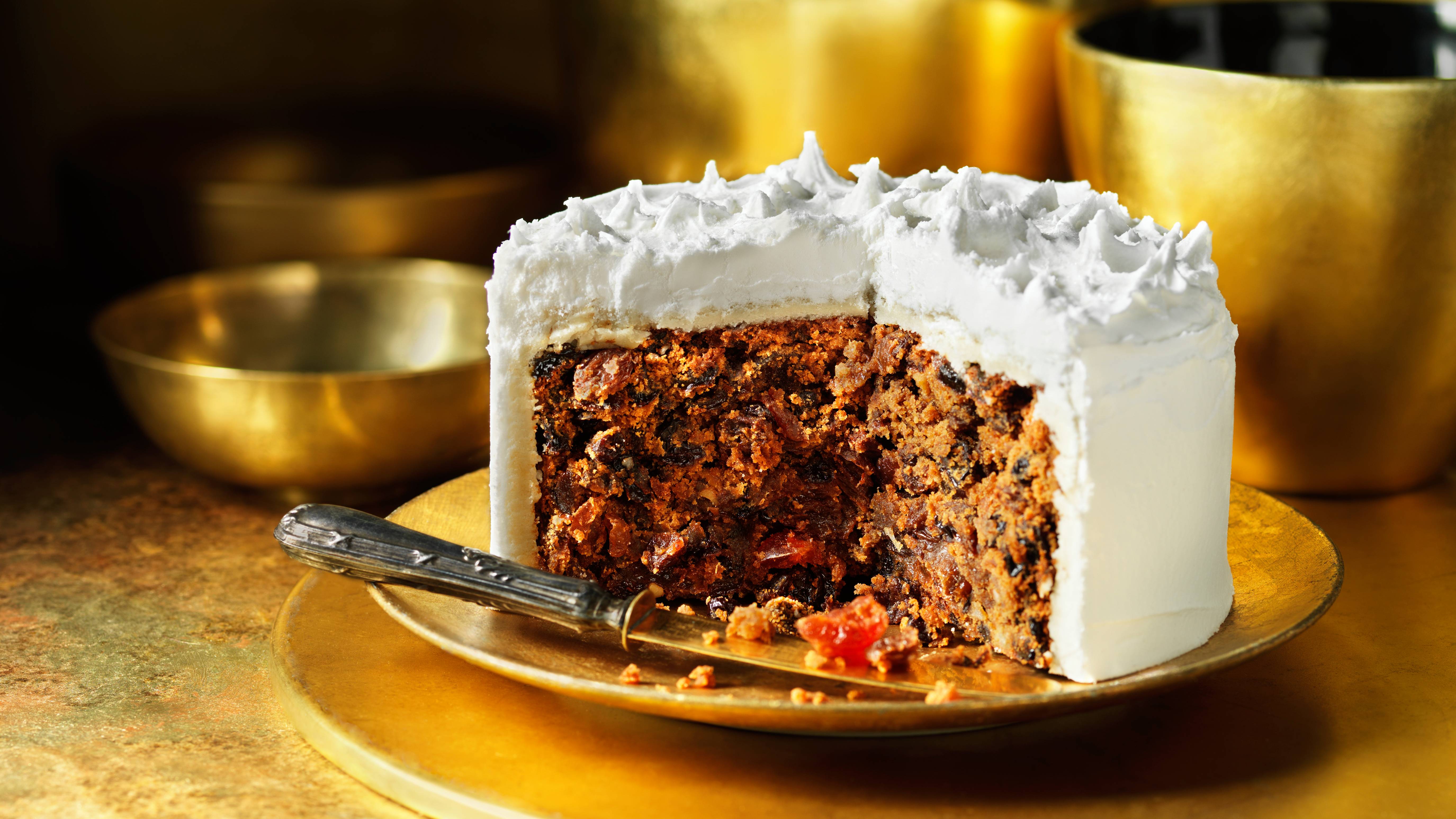
Jessica Ransom
Mary Berry’s Christmas cake is easy to make and serves at least 12 people. Decorate with marzipan and icing or keep it plain and simple with some fruit and nuts on top.
If you like Mary Berry’s fruit cake but want something iced, this is the recipe for you. Mary uses the classic combination of marzipan and royal icing to decorate her Christmas cake but you could use readymade fondant icing if you prefer and can omit the marzipan if you don’t like the flavour.
Ingredients
- 175g (6oz) raisins
- 350g (12oz) glacé cherries, rinsed, thoroughly dried and quartered
- 500g (1lb 2oz) currants
- 350g (12oz) sultanas
- 150ml (¼ pint) sherry, plus extra for feeding
- Finely grated zest of 2 oranges
- 250g (9oz) butter, softened
- 250g (9oz) light muscovado sugar
- 4 eggs
- 1 tbsp black treacle
- 75g (3oz) blanched almonds, chopped
- 75g (3oz) self-raising flour
- 175g (6oz) plain flour
- 1½ tsp mixed spice
To decorate:
- 3 tbsp apricot jam, sieved and warmed
- 600g shop-bought marzipan
- 600g royal icing cover 23cm/9in cake
- Icing sugar, for dusting (optional)
WEIGHT CONVERTER
Method
- Put the raisins, cherries, currants and sultanas into a non-metallic container, pour over the sherry and stir in the orange zest. Cover with a lid, and leave to soak for 3 days, stirring daily. When your fruit is sufficiently soaked and you’re ready to bake the cake, grease and line a 23cm (9in) deep round tin with a double layer of greased greaseproof paper.
- Heat the oven to 140C (120C fan, Gas 1).
- Put the butter, sugar, eggs, treacle and almonds into a very large bowl and beat well. Add the flours and mixed spice and mix thoroughly until blended. Stir in the soaked fruit. Spoon into the prepared cake tin and level the surface with the back of a spoon.
- Bake in the centre of the oven for 4-4½ hours or until the cake feels firm to the touch and is a rich golden brown. Check after 2 hours, and, if the cake is a perfect colour, cover with foil. A skewer inserted into the centre of the cake should come out clean. Leave the cake to cool in the tin.
- When cool, pierce the cake at intervals with a fine skewer and feed with a little extra sherry. Wrap the completely cold cake in a double layer of greaseproof paper and again in foil and store in a cool place for up to 3 months, feeding at intervals with more sherry. Don't remove the lining paper when storing as this helps to keep the cake moist.
- When you’re ready to decorate the cake, warm the apricot jam in a small saucepan or briefly in the microwave. Roll the marzipan to a thin circle that is bigger than your cake and will allow the sides to be covered. Alternatively, some people prefer a thicker disc of marzipan that sits on top of the cake, in this instance roll it to approximately 23cm diameter.
- Brush the cake all over with the warm jam then cover with the marzipan and use a cake smoother to make the paste flush with the cake.
- Spread the cake with royal icing using a small palette knife. You can opt for a completely smooth texture, or use the palette knife to flick the icing upwards and create peaks.
- Alternatively, you can use the back of a spoon to create texture by pushing it against the icing and pulling away from the cake. Leave to set, then dust with icing sugar and top with your chosen cake topper or decoration.
Top tips for making Mary Berry’s Christmas cake recipe
Please note, that nutritional info is per person based on this cake being divided by 15 people equally. The nutritional values also include the icing, marzipan, and jam used to decorate this Christmas cake.
What is royal icing?
Royal icing is a smooth paste of icing sugar that is mouldable when fresh but sets to a hard outer edge. It's ideal for wintery cakes because you can smooth it over cakes like a snowdrift, or rough it up into little peaks for a different snowy effect.
If you can’t find shop-bought royal icing or you'd rather make your own royal icing, combine 400g icing sugar with 2 egg whites and a squeeze of lemon juice. Whisk the eggs lightly. Put the icing sugar in a large mixing bowl. Make a well in the middle, then pour in the egg whites and mix well, adding 1 tsp lemon juice.
What can I do with leftover royal icing?
Use any that's leftover to decorate gingerbread man biscuits or small festive cupcakes. Store it in the fridge covered with a damp cloth or clingfilm. When you’re ready to use it again bring it to room temperature and stir well. You will need to mix with a spoon or whisk until the icing regains a thicker texture.
When should I make this Christmas cake recipe?
For the ultimate Christmas cake, Mary recommends baking your cake in September. Some recipes say that six weeks is fine, but this may result in a more crumbly texture and the cake won’t have the chance to soak up the full quota of booze it needs for a full festive flavour.
How long should you soak fruit for Christmas cake?
Mary Berry says: 'Allow three days for marinating the fruit in sherry. This is essential to plump up and flavour the fruit. If you cut the soaking time, there will be surplus liquid which will alter the texture of the cake.'
What alcohol do you soak fruit in for Christmas cake?
This recipe calls for sherry, but brandy and rum make for nice alternatives. Don’t be tempted to go too cheap on the booze, as it tends to pack a flavourful punch, and you can really notice the difference in the final cake.
Should I wrap Christmas cake in foil?
Yes, but make sure you wrap it in a double layer of greaseproof paper or baking parchment first as the cake may react with the foil. Two layers of foil should keep the cake airtight.
Can I wrap Christmas cake in cling film?
Yes, although greaseproof paper and foil are preferable. As you’ll be regularly unwrapping the cake and dousing it in sherry, foil and paper will be much easier to rewrap.
What is "feeding" a cake and how does Mary Berry do it?
Feeding a Christmas cake means pricking the surface with a fine skewer and pouring a little sherry over it. Pricking the cake allows the sherry to be absorbed into the depths of the sponge.
It's important because it keeps the cake moist and well preserved, and intensifies those rich fruity flavours. Feed it once a week, without removing the greaseproof paper as this keeps it moist.
Can I make an alcohol-free Christmas cake?
Absolutely. Simply replace the alcohol with orange, grape, or apple juice. The end result won’t have quite the same flavour, but it will still be rich and fruity. Because it does not have alcohol as a preservative, it won't keep as well as usual, so it's best to make it only about a month in advance.
Can you bake a cake in an AGA oven?
If, like Mary, you have an Aga, it’s easy to cook the cake here instead of a conventional or fan oven. Mary recommends mixing the cake the day before and then baking it in the simmering oven compartment the next morning.
This can take anywhere from 5-15 hours depending on your simmering oven so you will need to keep an eye on the cake. As always, bake until a skewer inserted comes out clean.
Mary adds: ‘If your Aga is old and the Simmering Oven exceedingly cool, start the cake off in the Roasting Oven on the grid shelf on the floor with the cold plain shelf above on the second set of runners. Allow to become pale golden, then carefully transfer to the Simmering Oven to bake [until cooked through].’
What can I put on a Christmas cake instead of icing?
If you don’t like marzipan or icing but want to make your Christmas cake look impressive, Mary has an easy solution. Simply brush the cake with the warm apricot glaze then cover with nuts and dried or glacé fruits.
Cherries, apricots, dates, walnuts, pecans, almonds and pistachios are all excellent festive choices.
Mary Berry's Family Sunday Lunches: Over 150 Delicious Recipes for a Relaxed Sunday Lunch by Mary Berry (Headline Home, £9.99) - View at Amazon
<p>This book has plenty more recipes that are perfect for the festive season and beyond. From how to cook the best roast dinner to more tempting bakes and cakes, Mary has a recipe for every occasion.You might also like Mary Berry’s Christmas pudding or you could try our easy Christmas cake recipe. We have plenty of Christmas cake decorations for you to browse as well as a guide on how to bake your Christmas cake in an air fryer.
Parenting advice, hot topics, best buys and family finance tips delivered straight to your inbox.

Mary Berry CBE is one of the most loved celebrity chefs in the country. In her early 80s, she’s been on our screens showing us how to make the most delicious recipes and sweet treats for over 50 years! Mary is probably most famous for being one of the original judges on The Great British Bake Off, where she put contestants through their paces for nine years before leaving the show when it made its controversial move from the BBC to Channel Four.
- Jessica RansomSenior Food Writer

